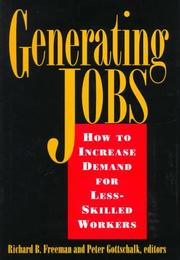| Listing 1 - 10 of 11 | << page >> |
Sort by
|

ISBN: 0674018109 Year: 1995 Publisher: New York Russell Sage Foundation
Abstract | Keywords | Export | Availability | Bookmark
 Loading...
Loading...Choose an application
- Reference Manager
- EndNote
- RefWorks (Direct export to RefWorks)
Income --- United States --- Income distribution --- Poverty --- Social policy --- Economic policy --- Economic policy. --- Income distribution. --- Labor market. --- United States of America
Digital
Year: 1997 Publisher: Place of publication unknown Luxembourg Income Study
Abstract | Keywords | Export | Availability | Bookmark
 Loading...
Loading...Choose an application
- Reference Manager
- EndNote
- RefWorks (Direct export to RefWorks)
Book
ISBN: 0871542277 9780871542274 Year: 1994 Publisher: New York (N.Y.): Russell Sage Foundation
Abstract | Keywords | Export | Availability | Bookmark
 Loading...
Loading...Choose an application
- Reference Manager
- EndNote
- RefWorks (Direct export to RefWorks)
330.564 <73> --- Verdeling van nationaal inkomen. Inkomensverdeling--Verenigde Staten van Amerika. VSA. USA --- 330.564 <73> Verdeling van nationaal inkomen. Inkomensverdeling--Verenigde Staten van Amerika. VSA. USA --- Income --- Income distribution --- Wages --- Labor market --- Tax incidence --- United States --- Economic conditions --- Income - United States --- Income distribution - United States --- Wages - United States --- Labor market - United States --- Tax incidence - United States --- United States - Economic conditions - 1981-2001

ISBN: 0871543605 Year: 1998 Publisher: New York Russell Sage Foundation
Abstract | Keywords | Export | Availability | Bookmark
 Loading...
Loading...Choose an application
- Reference Manager
- EndNote
- RefWorks (Direct export to RefWorks)
Job creation --- Labor demand --- Manpower policy --- Unskilled labor --- #SBIB:316.334.2A344 --- #SBIB:316.334.2A471 --- #SBIB:HIVA --- 332.224 --- 332.25 --- 332.630 --- 332.632.0 --- 332.70 --- US / United States of America - USA - Verenigde Staten - Etats Unis --- 331.5 --- 331.5 Arbeidsmarkt. Werkgelegenheid --(algemeen) --- Arbeidsmarkt. Werkgelegenheid --(algemeen) --- Laborers --- Low-skilled labor --- Low-skilled workers --- Labor --- Demand, Labor --- Demand for labor --- Labor market --- Supply and demand --- Arbeidssociologie: ongelijkheden op de arbeidsmarkt: positie van ongeschoolden op de arbeidsmarkt --- Arbeidssociologie: de overheid en het tewerkstellingsbeleid --- Minimumlonen --- Verminderd loon --- Strijd tegen de werkloosheid: algemeen. Theorie en beleid van de werkgelegenheid. Volledige werkgelegenheid --- Ondersteuning door het werk (algemeenheden) --- Geschoolde en ongeschoolde arbeid: algemeen --- Labour market --- United States --- United States of America
Book
ISBN: 1438433255 1441695419 9781441695413 9781438433257 9781438433233 1438433239 9781438433257 9781438433240 1438433247 Year: 2011 Publisher: Albany State University of New York Press
Abstract | Keywords | Export | Availability | Bookmark
 Loading...
Loading...Choose an application
- Reference Manager
- EndNote
- RefWorks (Direct export to RefWorks)
Looks at Western understandings of South Asian religions and indigenous responses from pre-colonial to contemporary times.
Hinduism. --- Religions --- Brahmanism --- South Asia --- Religion.
Digital
Year: 2011 Publisher: Cambridge, Mass. National Bureau of Economic Research
Abstract | Keywords | Export | Availability | Bookmark
 Loading...
Loading...Choose an application
- Reference Manager
- EndNote
- RefWorks (Direct export to RefWorks)
We estimate the trend in the transitory variance of male earnings in the U.S. using the Michigan Panel Study of Income Dynamics from 1970 to 2004. Using both an error components model as well as simpler but only approximate methods, we find that the transitory variance started to increase in the early 1970s, continued to increase through the mid-1980s, and then remained at this new higher level through the 1990s and beyond. Thus the increase mostly occurred about thirty years ago. Its increase accounts for between 31 and 49 percent of the total rise in cross-sectional variance, depending on the time period.

ISBN: 0511002564 9780511002564 0521562627 9780521562621 Year: 1997 Publisher: Cambridge Cambridge University Press
Abstract | Keywords | Export | Availability | Bookmark
 Loading...
Loading...Choose an application
- Reference Manager
- EndNote
- RefWorks (Direct export to RefWorks)
Income distribution --- Transfer payments --- Business & Economics --- Economic History --- Government transfer payments --- Payments, Transfer --- Expenditures, Public --- National income --- Distribution of income --- Income inequality --- Inequality of income --- Distribution (Economic theory) --- Disposable income --- Case studies. --- Case sudies --- Case studies --- Accounting --- 313 --- 330.580 --- 339.21 --- AA / International- internationaal --- CZ / Czech Republic - Tsjechië - Tchéquie --- DE / Germany - Duitsland - Allemagne --- FI / Finland - Finlande --- FR / France - Frankrijk --- GB / United Kingdom - Verenigd Koninkrijk - Royaume Uni --- HU / Hungary - Hongarije - Hongrie --- IE / Ireland - Ierland - Irlande --- NL / Netherlands - Nederland - Pays Bas --- US / United States of America - USA - Verenigde Staten - Etats Unis --- 330.1 --- 330.564 --- Levenswijze en levensstandaard. Levensminimum. sociale indicatoren (Studiën) --- Gecontroleerde economie. Geleide economie. Welvaarststaat. Algemeenheden --- Ongelijkheid en herverdeling van vermogens en inkomens. Inkomensbeleid --- Economische grondbegrippen. Algemene begrippen in de economie --- Verdeling van nationaal inkomen. Inkomensverdeling --- 330.564 Verdeling van nationaal inkomen. Inkomensverdeling --- 330.1 Economische grondbegrippen. Algemene begrippen in de economie --- Case sudies. --- Revenu --- Paiement de transfert --- Répartition --- Cas, Etudes de --- Income --- Income distribution - Case studies --- Transfer payments - Case sudies --- INCOME DISTRIBUTION --- ECONOMICS --- WELFARE
Digital
Year: 2010 Publisher: Cambridge, Mass. National Bureau of Economic Research
Abstract | Keywords | Export | Availability | Bookmark
 Loading...
Loading...Choose an application
- Reference Manager
- EndNote
- RefWorks (Direct export to RefWorks)
Nominal wage stickiness is an important component of recent medium-scale structural macroeconomic models, but to date there has been little microeconomic evidence supporting the assumption of sluggish nominal wage adjustment. We present evidence on the frequency of nominal wage adjustment using data from the Survey of Income and Program Participation (SIPP) for the period 1996-1999. The SIPP provides high-frequency information on wages, employment and demographic characteristics for a large and representative sample of the US population. The main results of the analysis are as follows. 1) After correcting for measurement error, wages appear to be very sticky. In the average quarter, the probability that an individual will experience a nominal wage change is between 5 and 18 percent, depending on the samples and assumptions used. 2) The frequency of wage adjustment does not display significant seasonal patterns. 3) There is little heterogeneity in the frequency of wage adjustment across industries and occupations. 4) The hazard of a nominal wage change first increases and then decreases, with a peak at 12 months. 5) The probability of a wage change is positively correlated with the unemployment rate and with the consumer price inflation rate.
Book
Year: 2011 Publisher: Cambridge, Mass. National Bureau of Economic Research
Abstract | Keywords | Export | Availability | Bookmark
 Loading...
Loading...Choose an application
- Reference Manager
- EndNote
- RefWorks (Direct export to RefWorks)
We estimate the trend in the transitory variance of male earnings in the U.S. using the Michigan Panel Study of Income Dynamics from 1970 to 2004. Using both an error components model as well as simpler but only approximate methods, we find that the transitory variance started to increase in the early 1970s, continued to increase through the mid-1980s, and then remained at this new higher level through the 1990s and beyond. Thus the increase mostly occurred about thirty years ago. Its increase accounts for between 31 and 49 percent of the total rise in cross-sectional variance, depending on the time period.
Book
Year: 2010 Publisher: Cambridge, Mass. National Bureau of Economic Research
Abstract | Keywords | Export | Availability | Bookmark
 Loading...
Loading...Choose an application
- Reference Manager
- EndNote
- RefWorks (Direct export to RefWorks)
Nominal wage stickiness is an important component of recent medium-scale structural macroeconomic models, but to date there has been little microeconomic evidence supporting the assumption of sluggish nominal wage adjustment. We present evidence on the frequency of nominal wage adjustment using data from the Survey of Income and Program Participation (SIPP) for the period 1996-1999. The SIPP provides high-frequency information on wages, employment and demographic characteristics for a large and representative sample of the US population. The main results of the analysis are as follows. 1) After correcting for measurement error, wages appear to be very sticky. In the average quarter, the probability that an individual will experience a nominal wage change is between 5 and 18 percent, depending on the samples and assumptions used. 2) The frequency of wage adjustment does not display significant seasonal patterns. 3) There is little heterogeneity in the frequency of wage adjustment across industries and occupations. 4) The hazard of a nominal wage change first increases and then decreases, with a peak at 12 months. 5) The probability of a wage change is positively correlated with the unemployment rate and with the consumer price inflation rate.
| Listing 1 - 10 of 11 | << page >> |
Sort by
|

 Search
Search Feedback
Feedback About UniCat
About UniCat  Help
Help News
News